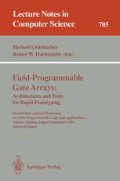Abstract
AT&T's ORCA (Optimized Reconfigurable Cell Array) architecture extends FPGA applicability into a larger domain than is possible with today's parts, including datapath intensive designs such as memory controllers, signal processing parts, and telecommunication interfaces. Key to the suitability of the ORCA for these jobs is the fact that each of its basic blocks is capable of processing four bits. So, for example, a 16 bit adder requires exactly 4 blocks, not 9 or 16 as in other architectures. Yet the total complexity of each block is comparable to other current parts, thus yielding a significant improvement in functional density.
Preview
Unable to display preview. Download preview PDF.
References
D. Hill, N-S Woo, “The Benefits of Flexibility in Lookup Table-Based FPGAs”, IEEE Transaction on CAD, Vol. 12, No. 2, pp. 349–353, February, 1993.
J. Rose, R. Frances, D. Lewis, P. Chow, “Architecture of Field-Programmable Gate Arrays: The Effect of Logic Block Functionality on Area Efficiency,” IEEE Journal of Solid State Circuits, Vol. 25. No. 5, pp. 1217–1225, October 1990.
D. Hill, D. Cassiday, “Preliminary Description of Tabula Rasa: An Electrically Reconfigurable Hardware Engine,” International Conference on Computer and Design 1990
D. Hill, “A CAD System for the Design of Field Programmable Gate Arrays,” Proc. of the 28th Design Automation Conference, June,1991
D. Hill, “A Specialized CAD Tool for Laying out a New FPGA Block,” 3rd Physical Design Workshop, 1991.
N-S Woo, “A Heuristic Method for FPGA Technology Mapping based on the Edge Visibility,” Proc. of the 28th Design Automation Conference, pp. 248–251, June 1991.
N-S Woo, “ATOM: Technology Mapping of Sequential Circuits for Lookup Table-based FPGAs,” AT&T Bell Laboratories, Technical Report, November 1991.
N-S Woo, M. Cantone, “Scuba: A Synthesis System from Module-based Description of Structured Circuits to ORCA FPGA,” AT&T Bell Laboratories, Technical Report, September 1992.
N-S Woo, J. Kim, “An Efficient Method of Partitioning Circuits for Multiple-FPGA Implementation,” To be presented at the 30th Design Automation Conference, June 1993.
Xilinx Programmable Gate Array User's Guide, Xilinx Corp., 1988.
ATT 3000 Series Field-Programmable gate Arrays, AT&T Microelectronics, August 1991.
Technical Data Book: XC 4000 Logic Cell Array Family, Xilinx, Corp., 1990.
ODS: ORCA Design System, AT&T Microelectronics, January 1993.
PREP Benchmark Examples, Programmable Electronics Performance Corporation, September, 1992.
Author information
Authors and Affiliations
Editor information
Rights and permissions
Copyright information
© 1993 Springer-Verlag Berlin Heidelberg
About this paper
Cite this paper
Hill, D. et al. (1993). ORCA: A new architecture for high-performance FPGAs. In: Grünbacher, H., Hartenstein, R.W. (eds) Field-Programmable Gate Arrays: Architecture and Tools for Rapid Prototyping. FPL 1992. Lecture Notes in Computer Science, vol 705. Springer, Berlin, Heidelberg. https://doi.org/10.1007/3-540-57091-8_29
Download citation
DOI: https://doi.org/10.1007/3-540-57091-8_29
Published:
Publisher Name: Springer, Berlin, Heidelberg
Print ISBN: 978-3-540-57091-2
Online ISBN: 978-3-540-47902-4
eBook Packages: Springer Book Archive

